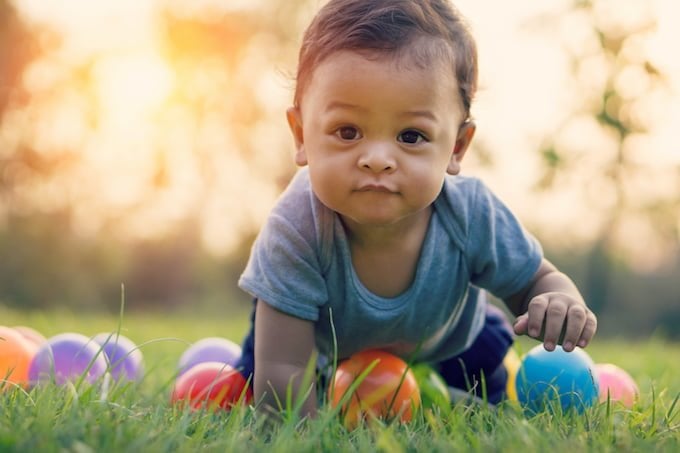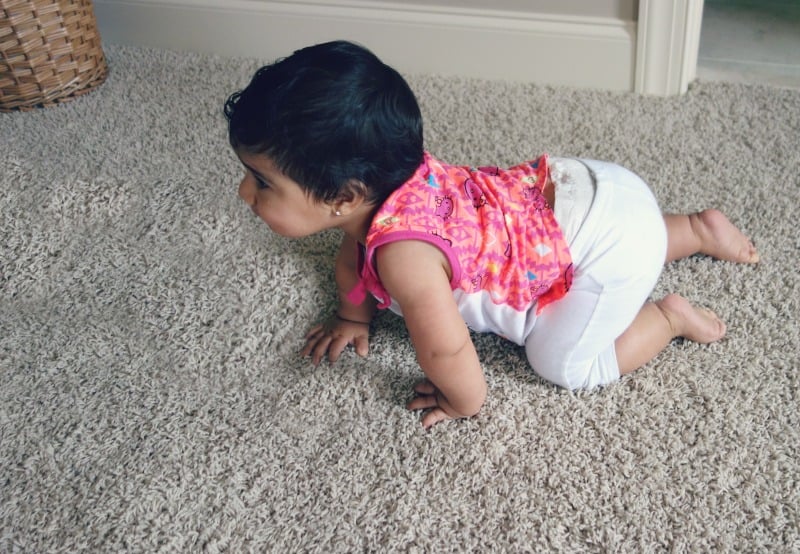Why Hands and Knees Crawling Is Important for Development
Sometimes we overlook the importance of developmental milestones like baby crawling on hands and knees. Eliza Parker is a certified Infant Developmental Movement Educator and trained Feldenkrais® practitioner, and here she shares advice on how and why parents should encourage their baby to crawl.
Many parents ask, “When do babies crawl?” and “Should I encourage my baby to crawl?”
These questions can become even more pressing if your child seems to be more interested in walking as an early mode of movement rather than crawling.
But when babies skip crawling on their hands and knees it may cause your child to miss some important developmental boosts, both mentally and physically.
Research has shown that baby crawling increases hand-eye coordination, gross and fine motor skills (large and refined movements), balance, and overall strength. These skill sets can help your baby reach important developmental milestones beyond mobility.
When Do Babies Start Crawling on Hands and Knees?
The crawling age starts as early as 6 months but can be delayed by an additional 4 months or more.
If your baby is nearing the crawling age, it’s a good time to consider the development benefits of crawling and ways to help baby crawl.
Let’s look at the two main types of baby crawling – belly crawling and hands and knees crawling.
Belly Crawling
It’s often referred to as commando crawling or pre-crawling, or crawling but belly crawling is a legitimate developmental movement pattern. It requires a very different coordination than hands-and-knees crawling.
Belly crawling offers the following benefits:
- Helps baby learn how to shift and manage body weight
- Supports reading
- Builds hand-eye coordination
- Helps reflexes integrate
- Shows the ankle, knee, and hip joints how to coordinate efficiently for hands and knees crawling and for standing/walking
- Leads to independent sitting
- Allows your baby to travel significant distance
Hands and Knees Crawling
This form of crawling is the focus of this article. And it offers many lifelong benefits to your child, such as:
- Crossing of information between brain halves: develops the band of nerve fibers between the brain’s hemispheres called the corpus callosum
- Ability to cross midline (to move a limb to the opposite side of the body)
- Organizes hips, knees, and lower back in preparation for standing and walking
- Supports reading skills
- Expands hand-eye coordination
We’ll cover each of these in depth below.
Unlike belly crawling, which relies on coordination of the same-side leg and arm when fully mastered, hands and knees crawling requires coordination of opposite-side limbs. This is called contra-lateral or cross-lateral (crossing sides).
This movement sequences diagonally through the body as the crawling baby reaches forward with one hand while her opposite knee follows.
Why is Criss-Cross Motion Important?
There’s an important pathway between the brain’s hemispheres—a band of nerve fibers called the corpus callosum. The criss-crossing of movement of baby crawling on hands and knees through the body supports this criss-crossing of information in the brain. That is, crawling helps develop this band of nerves that allows the hemispheres of Baby’s brain to communicate with each other.
Dr. Carla Hannaford explains in her book, Smart Moves: Why Leaning Is Not All in Your Head, “Cross lateral movements, like a baby’s crawling, activate both hemispheres in a balanced way. These activities work both sides of the body evenly and involve coordinated movements of both eyes, both ears, both hands and both feet as well as balanced core muscles.”
“When both eyes, both ears, both hands and feet are being used equally, the corpus callosum orchestrating these processes between the two hemispheres becomes more fully developed. Because both hemispheres and all four lobes are activated, cognitive function is heightened and ease of learning increases.”
What happens when crawling baby can then combine upper-lower and side-side coordination in her body? She can move diagonally (crossing sides). Additionally, with the spinal axis giving her an up and a down, she will now be able to move any way she wants, three dimensionally.
The Ability to Cross Midline
That is, to move a limb to the opposite side of the body. This is important for reflex integration, daily function, vision, hearing, and learning.
- Spine rotation: Crawling necessitates a twisting coordination through the torso.
- Strengthens the lower back in preparation for being upright
- Prepares the ankles for the bending and straightening needed later in walking
- Strengthens hand-eye coordination because it requires Baby to reach with her hands
Crawling Prepares the Hip Joints for Standing and Walking
Hands and knees crawling helps organize and shape the hip sockets.
As Keith Mankin, MD notes, “The muscle function starts to reshape the hips. As the hips reshape, pulled inward and forward by the muscle function, they become stronger and better positioned to lift the body and to start forward propulsion. And ultimately, these functional changes lead to increased strength and balance which lift the child upward into stance and walking.”
Crawling on Hands and Knees Supports Reading Skills
All this integration of brain halves, reflexes, and hand-eye coordination helps prepare the brain and body for reading.
Crawling supports learning, creative problem solving, and brain function in general—so it’s also beneficial at any other age!
Do Creative Crawling Options Count?
Some babies crawl with one knee and one foot or scoot on their bottom. These babies very wisely found a solution for getting around!
However, these options actually indicate that they’re having difficulty coordinating or weight bearing on both hands and both knees. There are many reasons why this can happen, from both internal and external influences.
So, when one of these is their only option, they can miss out on some of the benefits of crawling. If your baby is moving creatively, there are fun, noninvasive ways to encourage hands and knees crawling!
But Some Say Crawling Isn’t Important
You may hear this. It’s sometimes stated for the simple fact that crawling on hands and knees doesn’t always happen these days—so if babies aren’t doing it, it must not be important.
However, there are a few current parenting trends that can contribute to the inhibition of reflexes and typical motor development in general, such as propping in exersaucers or upright holding devices. An increase in the skipping of crawling points to these and other factors — it doesn’t indicate that crawling is not important (source).
Dr. Hannaford explains in her book, “We have known for years that children who miss the vitally important crawling stage may exhibit learning difficulties later on. Baby crawling on hands and knees, a cross-lateral movement, activates development of the corpus callosum.”
“This gets both sides of the body working together, including the arms, legs, eyes (binocular vision) and the ears (binaural hearing). With equal stimulation, the senses more fully access the environment and both sides of the body can move in a more integrated way for more efficient action.”
How to Get Baby to Crawl on Hands and Knees
There are some things you can do from the beginning, as well as at any stage, to help baby crawl.
• Provide your baby with as much floor time as possible. This will give them freedom to explore movement. It will be extra enticing if you join them on the floor!
• Look for ways to encourage your baby’s crawling by using their favorite toys as bait. Simply dangle the toy a few inches ahead of their grasp and continue to move the toy forward as baby moves toward it.
• Allow them to discover sitting and standing completely on their own. This will build adequate strength and coordination needed for supporting on hands and knees.
• As much as possible, avoid keeping your baby held directly upright in sitting and standing either by propping devices or by hand. This will help prevent them from developing excess tension that can make crawling harder and can even encourage scooting.
• Notice if your baby arches a lot, doesn’t want to curl into a ball and cuddle, doesn’t use both arms or legs, prefers to sit rather than move around on her tummy, habitually rolls long distances, may skip a milestone, or doesn’t seem to be interested in moving. These can be signs that respectful support could help provide your baby with more freedom of movement.
• Lastly, when helping your baby crawl, always listen to your gut feelings, even if you’re told not to worry about it or that your baby will grow out of it. Getting your little one crawling on hands and knees is important.
There’s no rush for a crawling baby to stand and walk. Allow baby to crawl for as long as they will, without “walking” them, until they choose to walk on their own.
Many Kids Can Retroactively Gain this Skill
If you’re read this with a feeling that you did something wrong because your child skipped the crawling on hands and knees phase, don’t feel bad. You’re far from alone.
The good news is, we can train our bodies and brains with the criss-cross motion at nearly any age.
All you have to do is get on the floor and crawl with your kids.
- Follow the cross lateral movements described above.
- Be patient as the brain and body learn to coordinate. It might take time.
- For teens or tweens, turn it into a workout. Start with the mountain climber move and then turn it into a crawl.
- It won’t take long for many kids, but remain encouraging if your child struggles with the coordination.
As your child gets older, learn more about how criss cross motions, outdoor play, climbing, and hanging upside down all support the vestibular system in kids.




